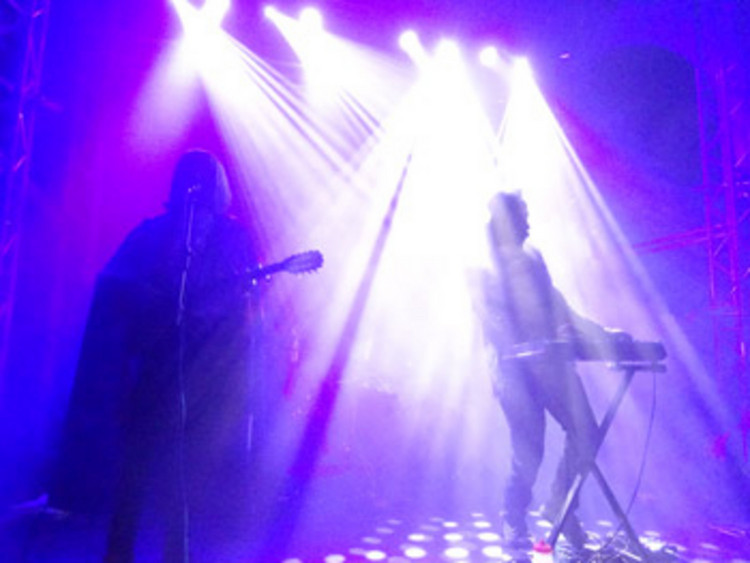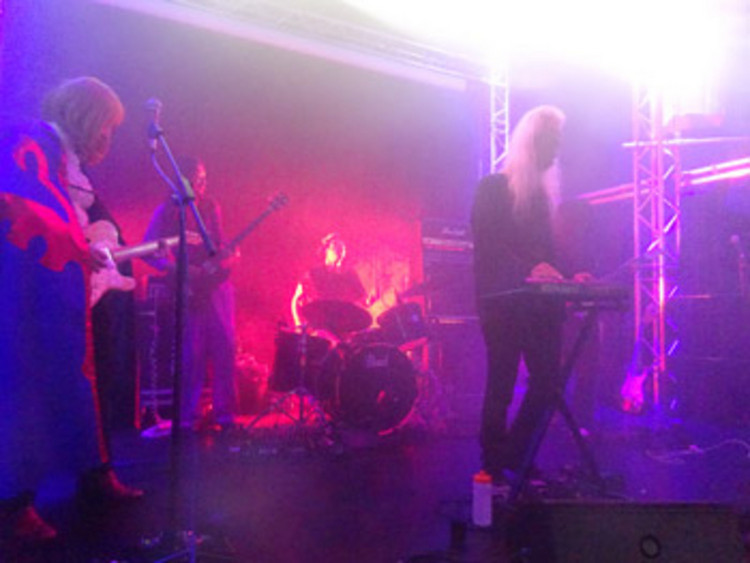Music > Live Reviews
Acid mothers Temple - Our Quiet Friends
Norwich Arts Centre
13/10/19

Acid Mothers Temple is not so much a band, as a way of being, with founder member Kawabata Makoto fronting its Melting Paraiso U.F.Oincarnation for over twenty years. Together with long-time collaborator, the magnificently bewhiskered Higashi Hiroshi, he has been coming to Norwich with a line-up that has varied over the years, but always with the singular noble intention of taking us all on a mind bending trip out into space. After a few years performing at the Waterfront Studio, and before that the Owl Sanctuary, it is surely fitting that the spaceship has at last landed at the Arts Centre. What better place, after all, to worship at the temple of Acid Mother than the deconsecrated shell of St Swithin's Church?
However, before AMT took to the stage, Norwich based Our Quiet Friends got to try out the NAC’s new PA system and the swanky new stage lights. On first name terms only, Ed and Leo double up on guitar (with Ed occasionally operating his synth from out of a briefcase) while Joe holds it all together with his considerable drumming skills. Showcasing their recently released EP, The Curve of Things, (inexplicably not for sale “because nobody does that any more”) they revealed a live sound that is much stronger, and much more substantial, than their media presence suggests. As one song blended into another, there was little opportunity for the audience to show its appreciation, but it was evidently there on the occasions Ed tipped us off with diffident thanks between tunes. Their loud, psychedelic sound brought to mind, not for the last time of the evening, the space rock of Hawkwind, notwithstanding vocals from Ed that owed more to the drawl of Magazine’s Howard Devoto. It was an eccentric mix, but let’s face it - who wouldn’t play good money to see that combo?
Acid Mother Temple are a quite extraordinary genre-defying ensemble of talented Japanese musicians that from the outset delivered a wall of thunderous sound that was energising, uplifting and just a bit bonkers. Thrillingly blending progressive, space and krautrock into a heady cocktail of quite magnificent noise, there were evident parallels with the musical eclecticism and philosophy of the extended Gong family, but if comparisons are at all helpful, then look no further than the aforementioned Hawkwind in the early seventies, when Lemmy first started strumming his bass, and Dik Mik fitted a ring modulator to his audio generator. Higashi Hiroshi showcased some fine knob twiddling, S/T strummed just like Lemmy used to, while Satoshima Nani’s muscular and incessant drumming brought to mind Terry Ollis at his most frenetic. This is not a band to look backwards, however, as evidenced by Kawabata Makoto’s colossal presence. Looking as if he has stepped out of a Kurosawa film, he squeezed some fabulous noises from his guitar that were nicely counterpointed by the relative delicacy of newcomer Jyonson Tsu’s playing. Stepping into the big shoes of much missed, and frequently cross-dressing, Mitsuko Tabata, he cut a dash of his own with preposterous wig and wizard cape. His haunting and ethereal vocals - closer to Adhan than singing – added an extra dimension to a sound that was already a dense and hypnotic brew.

Without intended to traduce the form, it is often the case with “this sort of music” that folk will watch in with studied concentration, while others come away quite happy having indulged in occasional bouts of rhythmic head nodding. Sometimes there is an almost perverse contradiction between the noise on stage and the sedimentary demeanour of its fans. That wasn’t the case at the Arts Centre, however. While there were still those that stood in mute appreciation with the stillness of an Easter Island statue – and good luck to them - there was also a surprisingly youthful quota of spangle-eyed hand wavers and pixie footed dancers conspiring to defy the norm and exuberantly enjoy themselves. By close of play there was even the making of a minor mosh pit, albeit a very polite one, which must have pleased the band hugely.
Here was a set that was built around extended riffs, teasingly edging towards accessibility before galloping forward again, only to then capitulate into frenzied freak outs. I’m fairly confident that it started off with Black Magic Satori and that somewhere along the way we got to hear Dark Star Blues. The seminal, and epic, Pink Lady Lemonade made repeated appearances, and I think we got a nod to Gong’s Flying Teapot along the way. Beyond that, however, I would be guessing, and I have some sympathy for those in attendance that sloped off to the bar during an unusually lengthy set that frequently seemed to spin out of control. I can only say that, for me, the band remains one of the most exhilarating and audacious live experiences you can have. The fact that they’re not everyone’s cup of tea, frankly only adds to the fun.
